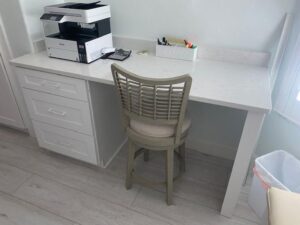Redesigning your kitchen can be a daunting task, especially when it comes to choosing the right cabinets. Semi-custom kitchen cabinets offer a perfect balance between bespoke design and affordability, allowing homeowners to personalize their kitchens without breaking the bank. This article will delve into the types of kitchen cabinets, materials, door styles, and more, guiding you through the process of unlocking the value of semi-custom kitchen cabinets.
I. Types of Kitchen Cabinets
When planning your kitchen renovation, it’s crucial to understand the different types of kitchen cabinets available. Let’s explore the main categories:
A. Base Cabinets
Base cabinets are the foundation of your kitchen, installed directly on the floor and supporting countertops, sinks, and other heavy items. They provide essential storage space and are often equipped with drawers and shelves for organizing kitchen essentials.
B. Wall Cabinets
Wall cabinets are mounted on the walls above the countertops, offering additional storage without occupying floor space. These cabinets are perfect for storing dishes, glassware, and small kitchen appliances, keeping them within easy reach.
C. Tall Cabinets
Tall cabinets, also known as pantry cabinets, extend from the floor to the ceiling. They offer substantial storage capacity, ideal for pantry items, cleaning supplies, and even built-in ovens or microwaves.
D. Custom Cabinets
Custom cabinets are designed to meet specific needs and preferences, offering complete freedom in terms of dimensions, materials, and finishes. However, they can be quite expensive compared to semi-custom options.
II. Materials Used in Kitchen Cabinets
The material you choose for your kitchen cabinets can significantly impact their durability, appearance, and cost. Here are some common materials:
A. Wood
Wood is a classic choice for kitchen cabinets, offering timeless beauty and durability. Popular wood types include oak, maple, cherry, and walnut, each with its unique grain patterns and colors.
B. Plywood
Plywood is a cost-effective alternative to solid wood, consisting of multiple layers of wood veneers glued together. It is highly durable and resistant to warping, making it an excellent choice for kitchen cabinets.
C. Medium-Density Fiberboard (MDF)
MDF is an engineered wood product made from wood fibers and resin. It offers a smooth surface, ideal for painted finishes, and is less expensive than solid wood or plywood.
D. Stainless Steel
Stainless steel cabinets are known for their modern, industrial look and exceptional durability. They are resistant to heat, moisture, and stains, making them a practical choice for contemporary kitchens.
E. Melamine
Melamine cabinets are made from particleboard or MDF coated with a melamine resin. They are available in a wide range of colors and finishes, providing an affordable and low-maintenance option for kitchen cabinets.
III. Cabinet Door Styles
The style of your cabinet doors can dramatically influence the overall look of your kitchen. Here are some popular door styles:
A. Shaker
Shaker doors are characterized by their simple, clean lines and recessed panel design. They are versatile and can complement both traditional and modern kitchen styles.
B. Louvered
Louvered doors feature horizontal slats, providing a unique, airy look. They are often used in spaces where ventilation is needed, such as laundry rooms or pantry cabinets.
C. Flat Panel
Flat panel doors, also known as slab doors, have a minimalist design with a flat, smooth surface. They are ideal for modern and contemporary kitchens, offering a sleek and clean appearance.
D. Inset
Inset doors are set within the cabinet frame, creating a flush, seamless look. This style requires precise craftsmanship and can be more expensive, but it offers a high-end, custom appearance.
E. Distressed
Distressed cabinet doors are intentionally aged or weathered to create a rustic, antique look. This style is perfect for farmhouse or vintage-inspired kitchens.
IV. Choosing the Right Kitchen Cabinets
Selecting the right kitchen cabinets involves considering various factors to ensure they meet your needs and fit your space. Here’s what to keep in mind:
A. Assessing Your Kitchen’s Layout
Evaluate your kitchen’s layout to determine the best cabinet configuration. Consider the work triangle (sink, stove, refrigerator) and ensure there’s ample space for movement and workflow.
B. Determining Your Storage Needs
Identify your storage requirements based on your cooking habits and the items you need to store. This will help you decide on the number and type of cabinets needed.
C. Considering Your Budget
Set a realistic budget for your kitchen cabinets. Semi-custom cabinets offer a good balance between customization and cost, allowing you to achieve a tailored look without overspending.
D. Matching Your Home’s Style
Choose cabinet styles and finishes that complement your home’s overall design. Whether your home is traditional, modern, or somewhere in between, there’s a cabinet style that will enhance its aesthetic.
V. Cabinet Hardware
Cabinet hardware, such as knobs, pulls, hinges, and latches, plays a crucial role in both functionality and style. Here are some options:
A. Knobs
Knobs are small, often round hardware pieces attached to cabinet doors and drawers. They come in various materials and designs, adding a decorative touch to your cabinets.
B. Pulls
Pulls, also known as handles, are longer than knobs and provide a different grip. They can be sleek and modern or ornate and traditional, depending on your preference.
C. Hinges
Hinges are essential for the smooth operation of cabinet doors. There are various types, including concealed hinges for a clean look and decorative hinges for added flair.
D. Latches
Latches keep cabinet doors securely closed. They are available in different styles, from magnetic latches to traditional hook-and-eye designs.
VI. Maintaining and Cleaning Kitchen Cabinets
Proper maintenance and cleaning can extend the life of your kitchen cabinets and keep them looking their best. Here are some tips:
A. Regular Cleaning Tips
- Wipe down cabinet surfaces regularly with a damp cloth to remove dust and grime.
- Use a mild detergent for deeper cleaning, avoiding harsh chemicals that can damage the finish.
- Dry the cabinets thoroughly after cleaning to prevent moisture damage.
B. Dealing with Stains and Spills
- Clean up spills immediately to prevent stains and water damage.
- For stubborn stains, use a mixture of baking soda and water to gently scrub the affected area.
- Avoid abrasive cleaners that can scratch the surface of your cabinets.
C. Long-Term Maintenance
- Check and tighten hardware periodically to ensure doors and drawers operate smoothly.
- Reapply finish or paint as needed to keep your cabinets looking fresh.
- Inspect for signs of wear or damage and address issues promptly to prevent further deterioration.
VII. The Process of Installing Kitchen Cabinets
Installing kitchen cabinets can be a complex process, but with careful planning and preparation, you can achieve professional results. Here’s an overview:
A. Measuring Your Space
Accurate measurements are crucial for a successful installation. Measure the height, width, and depth of your kitchen space, accounting for any obstacles or irregularities.
B. Preparing for Installation
- Clear the kitchen area and remove old cabinets, if necessary.
- Ensure walls and floors are level and make any necessary repairs.
- Gather all tools and materials needed for installation.
C. The Installation Process
- Start with the base cabinets, aligning them with your measurements and securing them to the wall and floor.
- Install wall cabinets next, ensuring they are level and properly aligned with the base cabinets.
- Add any tall or custom cabinets, making sure they fit seamlessly into the overall layout.
D. Post-Installation Checks
- Verify that all cabinets are securely fastened and level.
- Test the operation of doors and drawers, making any necessary adjustments.
- Install cabinet hardware, such as knobs, pulls, and hinges.
VIII. The Impact of Kitchen Cabinets on Home Value
Kitchen cabinets can significantly impact the resale value of your home. Here’s how:
A. How Cabinets Affect Home Resale Value
Well-designed and high-quality kitchen cabinets can enhance the overall appeal of your home, making it more attractive to potential buyers. Modern, functional cabinets can be a major selling point.
B. The Cost vs. Value of Upgrading Cabinets
While upgrading kitchen cabinets can be a significant investment, it often yields a high return. Homebuyers are willing to pay more for a kitchen with beautiful, durable cabinets, making it a worthwhile renovation.
IX. Sustainable and Eco-Friendly Cabinet Options
For environmentally conscious homeowners, there are several sustainable cabinet options available:
A. Reclaimed Wood Cabinets
Reclaimed wood cabinets are made from salvaged wood, reducing the need for new timber and giving new life to old materials. They offer a unique, rustic look and are environmentally friendly.
B. Bamboo Cabinets
Bamboo is a fast-growing, renewable resource, making it an excellent choice for eco-friendly cabinets. Bamboo cabinets are durable and offer a sleek, modern appearance.
C. Low-VOC Cabinets
Low-VOC (volatile organic compounds) cabinets are made with materials and finishes that emit fewer harmful chemicals, improving indoor air quality and reducing environmental impact.
X. Conclusion: Making the Most of Your Kitchen Cabinets
A. Recap of Key Points
Choosing the right kitchen cabinets involves understanding the different types, materials, and styles available. Semi-custom cabinets offer a balance of customization and affordability, making them an excellent choice for many homeowners. Proper maintenance and careful installation can ensure your cabinets last for years and add value to your home.
B. Final Thoughts on Choosing and Maintaining Cabinets
Investing in high-quality kitchen cabinets can transform your kitchen into a functional and stylish space. By considering your needs, budget, and home
Contents
- 1 I. Types of Kitchen Cabinets
- 2 II. Materials Used in Kitchen Cabinets
- 3 III. Cabinet Door Styles
- 4 IV. Choosing the Right Kitchen Cabinets
- 5 V. Cabinet Hardware
- 6 VI. Maintaining and Cleaning Kitchen Cabinets
- 7 VII. The Process of Installing Kitchen Cabinets
- 8 VIII. The Impact of Kitchen Cabinets on Home Value
- 9 IX. Sustainable and Eco-Friendly Cabinet Options
- 10 X. Conclusion: Making the Most of Your Kitchen Cabinets




